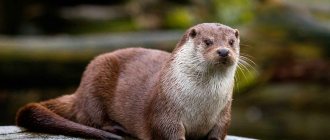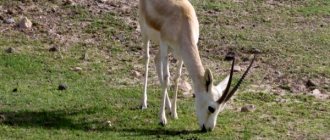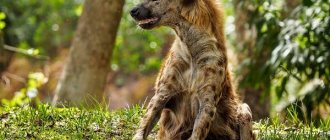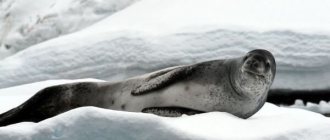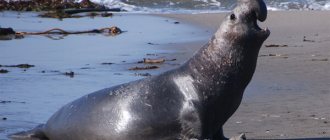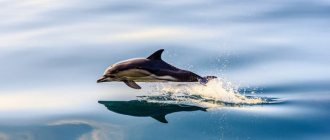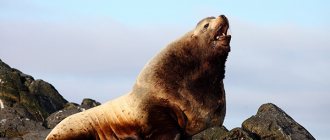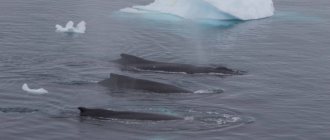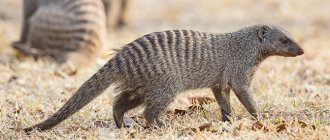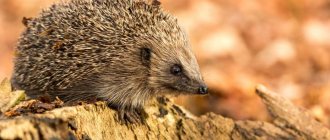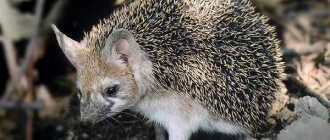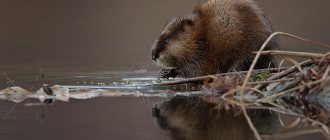- Wild animals
- >>
- Mammals
The sea otter is an aquatic member of the mustelid family, living along the Pacific coast of North America and Asia.
Sea otters spend most of their time in the water, but sometimes come ashore to sleep or rest. Sea otters have webbed feet, water-repellent fur that keeps them dry and warm, and nostrils and ears that close in water. The word “sea otter” appeared in Russian from the Koryak kalaga (kolakha) and is translated as “beast”. Previously, the name “sea beaver”, sometimes “Kamchatka beaver” or “sea otter” was used. In English-speaking countries the name "sea otter" is used.
Description and origin of the species
The predator is very different from other representatives of the Mustelidae family. The sea otter can live in water all its life without leaving the shore. In addition, the animal does not build a den on the shore, and does not have anal glands. Back in the 1980s, scientists considered the sea otter and seal to be the closest relatives. But according to DNA analysis, the animal's closest relatives are the European, spotted-necked, African and eastern clawless otters. These otters, along with the sea otter, descended from the same ancestor about 5 million years ago.
The animal was first described in the field notes of the German zoologist Georg Steller in 1751. The first scientific description of the animal was published in Carl Linnaeus' monumental work System of Nature in 1758. The animal was originally named Lutra marina, which translates from Latin as “sea otter.” The scientific name of the animal changed several times, including seals, otters, seals and martens, until the modern name Enhydra lutris was established in 1922.
The sea otter is the only representative of the genus Enhydra. The genus name is derived from the ancient Greek en
(in) and
hydra
(water), and literally means "in the water." The species name lutris is translated from Latin as “otter.” The Russian name sea otter was borrowed from the Koryak language. In Koryak, kalaga (kolaha) means “beast”. Previously, the animal was also called the sea beaver, but this is not quite the correct name, because the sea otter belongs to the Predator order, and the beaver belongs to the Rodent order.
History of discovery
When in 1741 the expedition of Vitus Bering crashed off the uninhabited islands, later called the Commander Islands, interesting animals of quite large size, with a strange appearance, which covered the coastal rocks in abundance and swam in the surrounding waters, appeared before the eyes of the team. The animals were not at all afraid of people, they allowed them to come almost close and, driven by curiosity, they swam up to the aliens’ boats and came to the fires of the sailors in trouble. These were sea otters, which were later introduced to the world as a sea beaver by the expedition naturalist Georg Steller.
What does a sea otter look like?
The sea otter is the heaviest predator of the Mustelidae family. Males weigh on average from 22 to 45 kg, with a body length of 1.2-1.5 meters. Some males weigh up to 54 kg. Females are much smaller in size. The average weight of a female is about 14-33 kg, and the body length is 1-1.4 m. Relative to body size, male sea otters have a disproportionately large baculum, about 150 mm in length and 15 mm thick at the base.
The physique of the sea otter resembles an ordinary otter, but is distinguished by a more massive, elongated, cone-shaped body. Unlike most marine mammals, the animal does not have blubber - a thick layer of fat under the skin that allows it to retain heat, so predators are forced to rely only on its fur.
The sea otter's fur is the thickest of all animals. There are about 150,000 hairs per 1 square cm of skin. The fur consists of long, waterproof guard hairs and short undercoat. The guard hair repels water and keeps the undercoat dry. Cold water does not reach the animal's skin, so heat loss from contact with water is minimal. The fur remains thick all year round as the animal sheds gradually throughout the year.
Since the waterproofing of the fur only works when the pelt is clean, the sea otter spends a lot of time cleaning the pelt. The animal can reach any point on its body thanks to its loosely hanging skin and extremely flexible skeleton. The color is usually dark brown interspersed with silver spots, but colors from yellowish and grayish-yellow to almost black are also found. The head, throat and chest of adults have lighter colored fur.
The predator is perfectly adapted to the marine environment. The animal's small ears and nostrils may close. The hind feet, which provide most of the stroke, are long, flat and webbed. The short and muscular tail helps with paddling. The front legs are very short, the claws on them are retractable, and the paw pads are rough, which allows the animal to grab slippery prey. The animal's bones are susceptible to osteosclerosis, and increased bone density reduces buoyancy.
Where does the sea otter live?
Sea otters live in coastal sea waters ranging from 15 to 23 meters deep, and usually do not swim more than 1 km from the shore. They are more common in areas protected from strong offshore winds, such as rocky coastlines, coral reefs and kelp forests. They prefer areas with rocky bottoms, but can also live where the bottom consists of sand, mud and silt. In the north, their habitat is limited by ice cover. Sea otters can survive on drifting ice floes, but will die if the sea is covered in solid ice.
The animal's habitat includes:
- Hokkaido island in northern Japan
- Kuril Islands, Commander Islands and Kamchatka in Russia
- states of Alaska, Washington, Oregon and California in the USA
- British Columbia in Canada
- the California Peninsula in northern Mexico
Currently, the animals have survived in approximately 2/3 of their historical habitat.
Habitat
These animals live in the coastal waters of the North Pacific Ocean. Their range covers the coasts of the Aleutian and Commander Islands, Kamchatka, Alaska and California. Usually sea otters are located at a distance of 10-80 m from the shore; in calm conditions they can move away from land several kilometers deep into the ocean. In general, they lead a sedentary lifestyle, although they do not have permanent areas and do not protect their territory. Places where sea otters gather are random; they arise spontaneously in shallow waters rich in food, protected from attacks by predators.
Sea otters spend most of their lives in the water and only climb out onto coastal cliffs or rocky shores to rest. They do not form large rookeries, like fur seals.
The sea otter is a purely diurnal animal. At night it usually sleeps on the shore (near the shore), and at dawn it goes out to sea, moving to feed no further than 25 km from the coast. Sometimes sea otters roost for the night among thickets of seaweed, the thickets of which serve as a reliable natural breakwater that dampens the waves rolling in from the ocean. Having dived under an almost continuous carpet of algae, the sea otters spin around, wrapping ribbons of seaweed around themselves so that they find themselves swaddled, after which, turning on their backs and putting their heads and bellies out of the water, the animals sleep.
What does a sea otter eat?
The sea otter feeds mainly on marine invertebrates, inhabitants of the seabed. Its diet includes more than 100 different species:
- sea urchins
- fat innkeeper worms
- various shellfish such as bivalves, sea mussels, abalone;
- crustaceans
- snails
The size of the predator's prey varies greatly - from small crabs to giant octopuses. All other things being equal, a sea otter will prefer larger prey. Sea otters eat fish only in the northern regions; predators living south of Alaska practically do not eat fish. Animals can change their diet depending on the food supply in the region. The sea otter's favorite food is sea urchins.
A sea otter must eat 25% to 38% of its body weight in food to compensate for the calories burned in cold water. Animals practically do not eat starfish, contrary to popular myth. Algae eaten by a predator are usually not digested.
In nature, sea otters are a system-forming species. Predators control the population of marine invertebrates, which has a positive effect on kelp forests. Kelp forests, in turn, take carbon dioxide from the atmosphere through photosynthesis. Thus, sea otters help in the fight against climate change.
Sea otter diet
Predators feed mainly during daylight hours, but sometimes they go hunting at night if there is a storm raging at sea during the day. The sea otter menu, consisting of marine life, is somewhat monotonous and looks something like this:
- sea urchins (basis of diet);
- bivalves/gastropods (2nd place);
- small fish (capelin, sockeye salmon and sand lance);
- crabs;
- octopuses (occasionally).
Thanks to the thickenings on the front legs and movable fingers, the sea otter picks up sea urchins, mollusks and crabs from the bottom, easily splitting their shells and shells using improvised tools (usually stones). When surfacing, the sea otter holds a stone on its chest and knocks on it with its trophy.
In zoos where animals swim in glass aquariums, they are not given objects with which they can break the glass. By the way, a sea otter that ends up in captivity becomes more bloodthirsty - it willingly eats beef and sea lion meat, and among smaller animals it prefers fish. Birds placed in the enclosure remain unattended, since the sea otter does not know how to catch them.
The sea otter has an excellent appetite - in a day it eats a volume equal to 20% of its weight (this is how the predator receives energy for heating). If a person weighing 70 kg ate like a sea otter, he would consume at least 14 kg of food daily.
The sea otter usually grazes in the intertidal zone, swimming near rocks or rocks protruding from the water: at this time, it inspects the algae, looking for marine life in it. Having discovered a bunch of mussels, the sea otter rips it out of the thicket, vigorously hitting it with its paws and immediately opens the valves to feast on the contents.
If the hunt takes place at the bottom, the sea otter examines it with its whiskers and methodically dives down every 1.5–2 minutes when sea urchins are detected. He picks them up in 5-6 pieces, floats up, lies on his back and eats them one by one, spreading them out on his belly.
The sea otter catches crabs and starfish on the bottom one by one, grabbing small animals with its teeth and large ones with its paws (including weighty fish). The predator swallows small fish whole, large fish piece by piece, settling in a “column” in the water. Under natural conditions, the sea otter does not feel thirsty and does not drink, receiving enough moisture from seafood.
Return to content
Character and lifestyle
The sea otter leads a diurnal lifestyle. The animal hunts and eats in the morning and evening, and rests for several hours during the day. Females with cubs are often forced to hunt at night. The animal spends from 25% to 60% of its time hunting, depending on the presence of cubs and the availability of food.
Sea otters spend most of their free time grooming themselves - cleaning their fur, untangling knots, removing loose hairs, rubbing their fur to squeeze out water and remove air, and blowing air into their fur. While eating, the animal often turns around in the water to wash food debris out of its fur.
The animals are quite talkative and make a wide range of sounds. The cries of puppies are similar to the cries of seagulls. Females make cooing sounds when they are happy, and males grunt and grunt contentedly. In moments of danger, animals hiss, whistle or scream.
Lifestyle
By their nature, sea otters are not nomadic animals; they are closely tied to the inhabited territory. The main part of their life passes in the water, where the animals, thanks to their buoyancy, not only feed, but also sleep, play and reproduce, without making any effort to stay on the sea surface. To prevent the current during sleep from carrying the animals far into the ocean, where there is no escape from predators, sea otters, floundering among long algae, wrap their bodies with them, literally becoming attached to the shallow water. They come ashore only to rest and in case of attack by sea predators. Kamchatka beavers live in groups of several dozen individuals and are distinguished by their friendly disposition towards any marine animals: seals, fur seals and birds. They communicate with each other by squeaking, and when threatened, they hiss.
On land, the sea otter moves with little difficulty: either by dragging its belly over the stones, or by arching its back high, but in the water the animals feel excellent. They usually swim at a speed of 5-8 km/h, and in case of danger they can accelerate to 16 km/h. Sea otters are excellent divers, diving to a depth of 20-25 m (sometimes 50 m), where they can stay for up to 5-8 minutes. In water they swim freely both on their belly and on their back, and on the surface they always stay upside down. In this position they feed, sleep, clean their fur and care for their young.
Social behavior in sea otters
Animals usually hunt alone, but prefer to rest in groups of several individuals of the same sex. On average, from 10 to 100 individuals gather in one group; groups with a maximum number of 2,000 animals have been observed. To prevent the sea otter from being carried out to sea while resting, the predator can wrap kelp algae around itself.
Although sea otters actively communicate with each other and spend a lot of time together, they are not truly social animals. Each adult animal spends a lot of time alone, and takes care of itself - feeding, defending itself and caring for its fur.
Among sea otters, only males defend their own territory. If a male lives in an area with a large number of females, his chances of successful mating increase markedly. Male sea otters typically defend their territory only from spring to fall because fall is the peak mating season. At this time, the male patrols the boundaries of his territory to scare away other males. However, it rarely comes to a fight between males.
Females move freely between the territories of different males. One male's area is usually home to 1 to 5 females. Males, who do not have their own territory, gather in large “male” groups and swim through the territories of females to find a mate.
Features of behavior
Sea otters are not too attached to any particular area and often leave it. In calm weather they feed in shallow places away from the coast, and in storms and winter they stay near the shore. The sea otter can stay in the sea for a long time without going ashore; it swims quickly (up to 12-16 km/h), frolics, and dives deeply. It swims by bending its whole body with motionless rear flippers.
Sea otters are skilled divers and can dive to several tens of meters (a maximum depth of 54 m has been recorded). They usually come to the surface to breathe every 50-90 seconds, but can remain underwater for up to 6 minutes.
On land, the sea otter moves with difficulty, dragging its belly along the ground and clumsily bending its body to the sides, slips on wet stones, and if the rock surface allows, it simply slides down on its belly. In the snow, the crawling body of a sea otter leaves a trace in the form of a rather deep groove, about 30 cm wide, along which the prints of the front and hind paws are clearly visible. Starting near the water, such a trail usually goes up the shore and ends in an oval bed, about a meter long and half a meter wide. The bed site is noticeable by heaps of feces, in which there are remains of shells of sea urchins and crabs, fragments of mollusk shells and fish bones. The track back to the sea is the same groove in the snow, but often without paw prints if the sea otter slides down without relying on its paws.
In case of sudden danger, the sea otter tries to move faster, arching its back and bringing its front and hind legs together. This way he can run a short distance and even make a few jumps.
Sea otters lead a solitary lifestyle most of the time. Females stay away from males, forming temporary pairs only during the mating season. During the mating season, male sea otters actively defend the territory they occupy, but contenting themselves with splashing their paws in the water and screaming when resolving territorial disputes, it rarely comes to a direct fight.
How does a sea otter swim?
Underwater, the animal pushes with its hind legs and tail, pressing its front legs to its chest. On the surface of the water it usually floats on its back. When swimming, a sea otter can reach speeds of up to 9 km/h. When resting, the sea otter puts all its paws on its body if the water is cold, and, on the contrary, keeps its paws in the water if it wants to cool down.
The body of the animal is very buoyant and does not sink for two reasons. Firstly, due to the increased volume of the lungs, the animal’s lungs are 2.5 times larger in volume than those of land mammals of the same size. Secondly, air is retained in the fur, which prevents the animal from drowning. The sea otter is capable of not leaving the water at all. On land, the animal waddles, has an awkward, rolling gait, and is capable of running with awkward jumps.
In muddy dark water, the predator searches for prey by touch, using whiskers and front paws. The animal's vision is worse than that of fur seals, and its hearing is not bad, but not outstanding. When hunting, the animal primarily relies on its sense of smell, and then on sight and hearing. The animal receives most of its water from food, however, unlike other marine mammals, the sea otter can drink sea water, and its kidneys are able to process salt water into fresh water.
Nutrition
In the afternoon, after feeding, sea otters go ashore to rest and sleep: with their short front legs, with rough pads instead of fingers, they first clean their eyes and whiskers, then their skin. Thick, soft, silky fur requires careful care; it is cleaned of algae scraps, then thoroughly smoothed. Then sleep continues for two or three hours, the sea otter sleeps very soundly and often gives the opportunity to come close to it on the shore or drive up in a boat. After a sound sleep, the animals doze for some time, opening their pink mouth with sharp teeth, stretching, turning over from side to side, yawning continuously, and when hungry they go back to the sea.
When getting food, the sea otter dives near the coastal rocks and collects urchins from the bottom or picks off clusters of mollusks from the stones. Having grabbed several hedgehogs with its front paws, it floats to the surface and lies on its back, placing its prey on its chest, in the folds of its skin. Having taken one of the hedgehogs, he twirls it with his front paws, breaking off and crushing the needles with his hard paw pads, without ever pricking himself, and then eats it. Having bitten through the shell of a hedgehog, the sea otter licks or scrapes out the contents with its paw, and throws away the remaining shell. After eating, the sea otter begins to scroll (spin) in the water, washing away any remaining food from its fur.
The sea otter is one of the few animals that can use tools. Large mussels, which serve as one of its main types of food, are covered with a black-violet, very durable shell, which is not easy to gnaw with teeth. For this purpose, the sea otter saves a fairly large stone (weighing up to 3.5 kg), previously selected at the bottom, and placing it on its belly, beats the mussel against the stone until the shell cracks. Having eaten, the sea otter does not throw away the stone, but again puts it “in its bosom” until the next meal.
Species of sea otter
Currently, 3 subspecies of sea otters are recognized, depending on their habitat.
- Sea otter E. l. lutris. The Asian sea otter lives from the Kuril Islands and northern Japan to the Commander Islands east of Kamchatka.
- Northern sea otter E. l. kenyoni The northern sea otter lives from the Aleutian Islands, along the coast of Alaska to Oregon.
- California sea otter E. l. nereis. The southern sea otter lives along the coast of central and southern California.
Some scientists also identify the Kamchatka sea otter E. l. kamtschatica, living in Kamchatka and the Kuril Islands. However, the Kamchatka subspecies was not officially recognized.
The common or Asian sea otter is the largest subspecies; it has a wider skull and a shorter nose compared to other subspecies. The Californian species has the smallest teeth and the longest jaws. In the northern subspecies, the lower jaw is longer than the upper.
Fur
Sea otter fur, exceptionally beautiful, soft, silky, and also very durable and wearable, is one of the most expensive in the world. He glorified the beast throughout the world - and almost destroyed it. “Just as the sable little by little brought the Russians to Kamchatka, so the even more expensive Kamchatka beaver (sea otter) led them further through the entire series of Aleutian Islands to the opposite continent, America,” - this observation by the 19th century naturalist Georg Hartwig noted the outstanding role of the sea otter in the development of Russian America. Precious fur lured Russian entrepreneurs to the East - to the lands discovered in 1741 by the Second Kamchatka Expedition. “The rumor about the riches of this newly discovered country,” wrote the historian Vasily Berkh, “aroused the enterprising spirit of the Siberian merchants, and the stories of Bering’s and Chirikov’s companions ignited an even stronger desire to enrich themselves with beaver pelts.”
In contrast to the “soft junk” (sable) mined in Siberia, which was taken for sale mainly in Europe, sea otter fur, which was held in high esteem by Chinese nobles, was sent to Kyakhta - the main point of trade between Russian merchants and the Chinese, where skins were exchanged for overseas goods, most often for tea. So it is no coincidence that it is believed that sea beaver fur contributed to the spread of tea drinking in Russia and the strengthening of business ties with China.
Reproduction of sea otters
Sea otters are polygamous - a male usually mates with several females. Temporary pairs occur only for a few days, between a male and a female during estrus. The peak mating season is usually in the fall. Mating occurs in water. During mating, males are very aggressive - they bite the female's nose, so that scars remain, or hold the female's head under water.
Male sea otters are notorious for their sexual appetite. Females sometimes die during mating, but this does not stop the male. Cases have been observed of males mating with a dead female a week after her death. In addition, male sea otters rape seal pups and, less commonly, other marine mammals. This usually ends in the death of the cub.
Animals give birth to young all year round due to the female's ability to delay pregnancy for up to 8 months. In northern populations, the peak birth rate occurs in May-June, in the south in January-March. Pregnancy can last from 4 to 12 months, since the fertilized egg does not enter the uterus immediately. Direct fetal development takes 4 months.
Baby sea otters
Females give birth directly in the water, with only 1 cub in the litter weighing from 1.4 to 2.3 kg. Twins account for only 2% of cases, and usually only one survives. Puppies are born sighted, with 10 baby teeth and dense baby fur. The mother licks the newborn for hours, after which so much air accumulates in the puppy’s fur that the cub floats like a cork and is sure not to drown.
The mother breastfeeds the cub for 6-8 months in California, and from 4 to 12 months in Alaska. Already at the age of several weeks, the mother teaches the puppy to swim and dive. From 2 months, the female feeds the puppy solid food. At 13 weeks, baby fluff is replaced by adult fur. At the age of 6-8 months, young sea otters usually become independent, but some individuals suckle breast milk for up to 1 year. Females reach sexual maturity at 3-4 years, males over 5 years of age.
Mortality among cubs is very high - no more than 25% of puppies survive to 1 year. Experienced mothers have a better chance of raising a baby. It happens that females have to abandon the cub because they cannot feed it.
Female sea otters are known for their devotion and motherly love. The mother devotes most of her time to the cub - endlessly licking the puppy's fur, and carrying it on her chest, protecting it from the cold sea water. During the hunt, the female leaves the cub on the surface of the water, sometimes wrapping it in kelp seaweed so that the cub does not get carried away by the current. If the cub does not sleep, it screams pitifully all the time until the mother returns. If the puppy dies, the mother does not leave its body for several days. Female sea otters often care for orphaned pups.
Description of the animal
Let's look at what a sea otter looks like, where it lives, and what it eats. To do this, let's get acquainted with the features of appearance and lifestyle.
What does it look like
The sea otter has a flexible body up to 1.5 m long. Due to this, it swims well in water. The weight of an adult is on average 20-40 kg. This species differs from the river otter. Males are much larger and heavier than females. The animals are not characterized by sexual dimorphism. Overall they look the same.
The hind legs of the animal have swimming membranes, the front legs are equipped with grasping fingers with claws. The tail of the mammal is small, but quite strong. Its length reaches 36-40 cm.
The sea otter's neck is not long, its head is rounded, and its ears are inconspicuous. Thick, warm fur 3 cm long allows the animal to lead a semi-aquatic lifestyle. His skin always remains dry, even if the cover is wet. The sea otter carefully maintains its fur, which has excellent thermal insulation.
In nature, brown individuals are most often found, white ones are rare. The sea otter's nose is usually black and its eyes have a brown tint. Life expectancy is 9-10 years. With good care in captivity, there are animals that die 20 years after birth.
The structure of the animal's teeth is different from the arrangement of other predators. It has 4 lower incisors like pinnipeds. These creatures are born with 26 teeth. In some cases their number reaches 34.
Video
Character and lifestyle
The sea otter is a very peaceful animal. It tolerates the proximity of other marine life, including birds. Sea otters live in small families and take responsible care of their offspring.
The sea creature has an amazing sense of smell, which compensates for poor hearing and vision. Due to the unique mustache, the sense of smell makes it possible to hunt successfully.
The sea otter can sleep on the water surface thanks to its large lungs. To prevent the current from carrying him away, he wraps himself in seaweed.
The animal's daily routine looks like this:
- The sea otter wakes up at dawn. It then dives for food, grooms its fur, and feeds.
- At 11-12 noon the creature sleeps for 30-60 minutes.
- Next comes the active period. The otter dives for food, grooms itself, swims and plays.
- At 15-16 hours the second sleep occurs, which lasts about an hour.
- The final daytime period is devoted to feeding, combing the coat, playing, and breeding.
- At sunset, the sea otter goes to bed and gets up only in the morning. Some animals prefer to rest on land, while others spend the night in the water.
When danger approaches, the sea otter dives deep into the water and develops good speed. The predator moves on land with difficulty and drags its stomach a little behind it.
What does it eat?
The animal needs energy, so it eats quite a lot. In total, its diet includes about 40 species of small animals.
The otter feeds mainly on crabs, shellfish, fish and sea urchins. She doesn’t mind eating abalone, chitons, scallops, and octopus. The predator hunts during the day or during bright nights.
Kalan is very smart. If he cannot bite through the crab shell, then he begins to hit it against a stone to break it. The predator rarely hunts fish. Its weak vision does not allow it to quickly focus on swimming prey. In shallow waters, the sea otter feeds on sockeye salmon, capelin, and sand lance.
When a fish is caught, the sea otter holds it under its arm or in its mouth. It feeds on it only on the water surface. If the prey is very large, the animal falls asleep with its remains, holding it on its stomach, and then eats it after sleep.
The predator drinks sea water in large quantities. This is due to the fact that his diet contains a lot of protein.
Where does it live?
There are three types of sea otters, which differ in their specific habitat:
- Asian (common) lives in Kamchatka, the Kuril and Commander Islands;
- southern (Californian) common in central California;
- the northern one is found in southern Alaska and the Aleutian Islands.
The sea otter lives on the coast of the Pacific Islands. You can see it in California, Japan, Canada. Individuals are found in Kamchatka and Alaska.
The sea otter is a relatively sedentary creature. It is characterized by local movements associated with seasonal changes and sea disturbances. During the development of a new territory, the animal migrates over a distance of more than 100 km. Individuals winter near the coast and come out onto rocks during storms.
Reproduction
Males are ready to breed at 5-6 years of age. They can retain the ability to reproduce until the end of their lives. Females reach sexual maturity at 4-5 years.
Two individuals of the opposite sex swim together for a long time, holding their paws and diving until the mating process itself begins. During copulation, the male holds the female by the nose with his teeth. At the end of mating, the sea otter bites its chosen one quite hard, leaving visible marks on the muzzle.
In rare cases, these manipulations become lethal for the female. She may drown under water or receive life-threatening injuries. Individuals breed all year round. No permanent pairs are formed.
Males do not fight for the female. But they court the opposite sex for a long time and reverently.
The animal's pregnancy lasts about 8 months. The mother carefully takes care of the baby:
- feeds;
- protects;
- cares for the coat;
- teaches you to survive.
After the baby is born, the male is no longer interested in the female.
Natural enemies
The sea otter is a fairly friendly animal towards other creatures. He lives quietly next to seals, fur seals, and sea lions. Sometimes the otter shares their beds with them. They fight extremely rarely. Confrontations can occur between males who are defending their territory.
One of the main enemies of the sea otter is the killer whale. On the shore, bears and people pose a danger to him. The list of enemies includes polar sharks and sea lions. The remains of sea otters are found in their stomachs.
Population
The population of sea otters previously reached 300,000, according to experts. Due to active hunting of animals in the 18th-19th centuries, the number of animals by the beginning of the 20th century had decreased to 1,000 - 2,000 individuals in 13 colonies. In 1911, Russia, Japan, the USA and Great Britain (for Canada) signed an agreement banning the commercial fur harvest of fur seals and sea otters in the North Pacific Ocean. At that time, many predicted the species' complete extinction.
Currently, the number of sea otters in the world is estimated at approximately 107,000 individuals.
- The most stable population is in Russia, about 27,000 animals. Of these, 19,000 live in the Kuril Islands, about 2,500 - 3,000 live in Kamchatka, and about 5,000 - 5,500 animals inhabit the Commander Islands. The number of animals in Russia today is close to its historical maximum of the 19th century.
- About 73,000 animals live in Alaska, which is 1.5 times less than in the 19th century.
- In British Columbia the population is fragmented and numbers approximately 5,600 animals.
- There are at least 2,000 sea otters in Washington state.
- Oregon has not had its own population since the early 20th century. There were attempts to release the animals into the wild in the 1970s, but they came to nothing. In 2022, 2 animals were spotted for the first time in 10 years.
- Only about 100 individuals live in California, despite the fact that there were once at least 16,000.
- In Mexico and Japan, populations are just recovering.
Fishing
Because of its valuable fur, the sea otter almost disappeared as a species from the face of the Earth. Immediately after Bering’s expedition in the mid-18th century, the Commanders, the Aleutian Islands and Alaska were full of seekers of happiness - “soft gold”. During the period from 1798 to 1845, the Russian-American Company sold 118,000 sea otter skins, and by 1867, the Russians exported 260,790 skins from Russian America. The Americans killed 90,000 sea otters in Alaska from 1871 to 1890, and in the next 10 years only 6,143 sea otters. In general, by the 20th century, sea beaver fishing in Russia and America had completely ceased. By this time, the global sea otter population had fallen from the 300,000 sea otter population in the 18th century to several thousand by 1911, when the fishery was ended by an International Convention signed by Russia, America, Japan and England (for Canada).
At first, they were hunted only on the more accessible Bering Island, and later, when the number of sea otters here catastrophically decreased, fishers reached Medny Island. And only the harsh sailing conditions off the rocky coast of Komandor, frequent storms and the lack of good anchorages saved the sea otters from complete extermination. By 1924, when the strictest ban on fishing for this sea animal was issued, only a few dozen of them remained, and then only on Medny Island.
Threats and protection of the species
During the 20th century, sea otters regained 2/3 of their historical habitat, which can be considered a huge success when compared with the deplorable state of the population at the beginning of the 20th century. However, the sea otter is still listed in the International Red Book with the status of a species in danger of extinction. Hunting of the animal is prohibited throughout its entire range, with the exception of limited harvest quotas for indigenous peoples in the United States.
Main threats to sea otters:
- marine pollution, especially oil spills;
- hunting by killer whales;
- poaching;
- fishing nets - animals get entangled in them and die.
The main threat at the moment is oil and petroleum product spills. Sea otters do not have thick blubber and rely on their fur as their main source of warmth. If oil gets on the skin of an animal, the thermal insulation of the fur is damaged, and the animal dies from hypothermia. When trying to cleanse the oil, the sea otter's liver, kidneys and lungs are severely injured.
Enemies
In the Aleutian Islands, the sea otter population declined catastrophically in the 1990s. American researchers suspect migratory killer whales are responsible for this: previously, the basis of their diet was large cetaceans, the reserves of which were undermined by whaling. And then the killer whales began to successively switch to feeding on seals, fur seals, sea lions, until the turn came to the smallest marine mammals - sea otters.
According to calculations, one killer whale can eat 1,825 sea otters in a year, and the disappearance of 40 thousand individuals from the islands over six years of observation could be a consequence of the predation of only four (3.7, to be exact) killer whales. The very fact of increased attacks by killer whales on seals and sea otters is beyond doubt. Why then does this species thrive on the neighboring Commander Islands? According to Kamchatka biologist Alexander Burdin, on the Commanders, migratory killer whales prefer to hunt more abundant and accessible fur seals, which serve as a kind of shield for other possible prey species, including sea otters.
